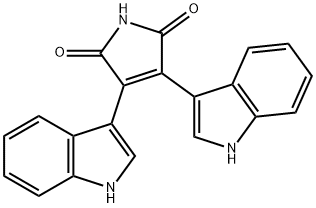3,4-Di-1H-indol-3-yl-1H-pyrrole-2,5-dione
Synonym(s):Arcyriarubin A, 2,3- bis(1H-Indol-3-yl)maleimide, Ro 31-6233;Bisindolylmaleimide IV - CAS 119139-23-0 - Calbiochem;Ro 31-6233
- CAS NO.:119139-23-0
- Empirical Formula: C20H13N3O2
- Molecular Weight: 327.34
- MDL number: MFCD00236432
- SAFETY DATA SHEET (SDS)
- Update Date: 2024-11-19 15:53:33

What is 3,4-Di-1H-indol-3-yl-1H-pyrrole-2,5-dione?
What are the applications of Application
Bisindolylmaleimide IV is a cell permeable potent & somewhat selective inhibitor of PKC & mild inhibitor of PKA
Definition
ChEBI: 3,4-bis(1H-indol-3-yl)pyrrole-2,5-dione is a member of indoles and a member of maleimides.
General Description
A potent, cell permeable, and selective inhibitor of protein kinase C (IC50 = 87 nM). Inhibits protein kinase A at much higher concentrations (IC50 = 2.7 μM).
Biological Activity
bisindolylmaleimide iv is a protein kinase c (pkc) inhibitor.the enzyme family protein kinase c2 (pkc) occupies a central role in the transduction of signals from a variety of mediators across the cell membrane.3 receptor occupation by a number of hormones, cytokines, neurotransmitters, and growth factors results in activation of pkc via activation of phospholipase c through either a g protein mechanism or a tyrosine kinase mechanism. pkc then propagates the signal by phosphorylation of proteins on serine or threonine, with atp as cosubstrate, resulting in modification of the properties of these proteins. thus pkc appears to regulate mechanisms of cell proliferation, secretion, and gene expression.
Biochem/physiol Actions
Target IC50: 87 nM against protein kinase C
in vitro
bisindolylmaleimide iv was identified as a cell permeable inhibitor of protein kinase c (pkc) with ic50 values from 0.10 to 0.55 μm. bisindolylmaleimide iv was designed to be more discriminative than its parent compound staurosporine, the non-selective pkc inhibitor. in addition, bisindolylmaleimide iv also found to be able to inhibit protein kinase a with ic50 values ranging from 2 to 11.8 μm [1, 2].
in vivo
animal study found that, in neonatal rats, high glucose levels could induce the hypertrophy of cardiomyocytes. ro-31-8220, a analog of bisindolylmaleimide viii, was able to reverse the effect of high glucose on the cardiac myocytes, which might be through pkc/nf-κb/c-fos pathway [3].
References
[1] davis, p. d.,hill, c.h.,lawton, g., et al. inhibitors of protein kinase c. 1.1 2,3-bisarylmaleimides. journal of medicinal chemistry 35, 177-184 (1992).
[2] toullec, d. ,pianetti, p.,coste, h., et al. the bisindolylmaleimide gf 109203x is a potent and selective inhibitor of protein kinase c. the journal of biological chemisty 266(24), 15771-15781 (1991).
[3] zhang, w. b. et al. reverse effect of protein kinase c inhibitor ro-31-8220 on the hypertrophy of cardiomyocytes of neonatal rats induced by high glucose levels. chinese journal of pathophysiology. 2009-08.
Properties of 3,4-Di-1H-indol-3-yl-1H-pyrrole-2,5-dione
| Melting point: | 161 °C |
| Boiling point: | 690.1±55.0 °C(Predicted) |
| Density | 1.486±0.06 g/cm3(Predicted) |
| storage temp. | -20°C |
| solubility | DMSO: soluble |
| form | solid |
| pka | 8.44±0.60(Predicted) |
| color | dark red |
Safety information for 3,4-Di-1H-indol-3-yl-1H-pyrrole-2,5-dione
Computed Descriptors for 3,4-Di-1H-indol-3-yl-1H-pyrrole-2,5-dione
New Products
Tert-butyl bis(2-chloroethyl)carbamate 4-Methylphenylacetic acid N-Boc-D-alaninol N-BOC-D/L-ALANINOL N-octanoyl benzotriazole 3-Morpholino-1-(4-nitrophenyl)-5,6-dihydropyridin- 2(1H)-one Furan-2,5-Dicarboxylic Acid DIETHYL AMINOMALONATE HYDROCHLORIDE 1,1’-CARBONYLDIIMIDAZOLE R-2-BENZYLOXY PROPIONIC ACID 1,1’-CARBONYLDI (1,2-4 TRIAZOLE) N-METHYL INDAZOLE-3-CARBOXYLIC ACID (2-Hydroxyphenyl)acetonitrile 4-Bromopyrazole 5-BROMO-2CYANO PYRIDINE 5,6-Dimethoxyindanone 5-broMo-2-chloro-N-cyclopentylpyriMidin-4-aMine 2-(Cyanocyclohexyl)acetic acid 4-methoxy-3,5-dinitropyridine 1-(4-(aminomethyl)benzyl)urea hydrochloride 2-aminopropyl benzoate hydrochloride diethyl 2-(2-((tertbutoxycarbonyl)amino) ethyl)malonate tert-butyl 4- (ureidomethyl)benzylcarbamate Ethyl-2-chloro((4-methoxyphenyl)hydrazono)acetateRelated products of tetrahydrofuran








You may like
-
 Bisindolylmaleimide IV CAS 119139-23-0View Details
Bisindolylmaleimide IV CAS 119139-23-0View Details
119139-23-0 -
 Bisindolylmaleimide iv 95% CAS 119139-23-0View Details
Bisindolylmaleimide iv 95% CAS 119139-23-0View Details
119139-23-0 -
 Bisindolylmaleimide IV CAS 119139-23-0View Details
Bisindolylmaleimide IV CAS 119139-23-0View Details
119139-23-0 -
 1975-50-4 98%View Details
1975-50-4 98%View Details
1975-50-4 -
 2-HYDROXY BENZYL ALCOHOL 98%View Details
2-HYDROXY BENZYL ALCOHOL 98%View Details
90-01-7 -
 14714-50-2 (2-Hydroxyphenyl)acetonitrile 98+View Details
14714-50-2 (2-Hydroxyphenyl)acetonitrile 98+View Details
14714-50-2 -
 118753-70-1 98+View Details
118753-70-1 98+View Details
118753-70-1 -
 733039-20-8 5-broMo-2-chloro-N-cyclopentylpyriMidin-4-aMine 98+View Details
733039-20-8 5-broMo-2-chloro-N-cyclopentylpyriMidin-4-aMine 98+View Details
733039-20-8